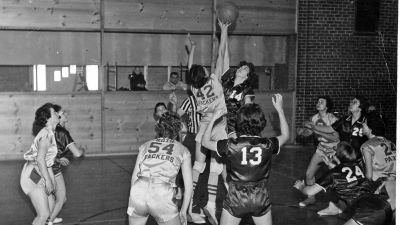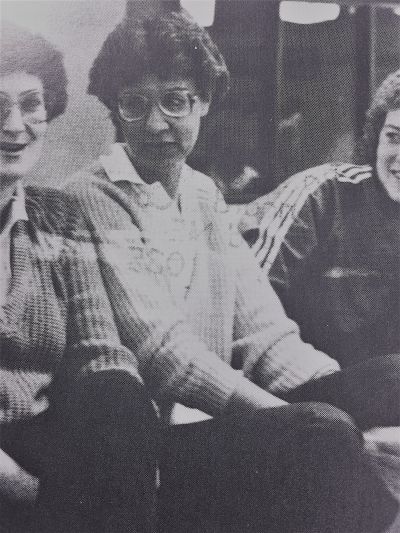
Dr. Eunice Goldgrabe chuckles when asked to compare female athletics at Concordia across eras. The spectacle of a female athletic event has changed dramatically since Goldgrabe graduated from Concordia in 1966 and then began a professional career in education and coaching. She can go on and on about the uniform situation. At one point, a mother of one of the volleyball players kindly made uniforms herself for a past Bulldog team.
Without question, nonexistent budgets were a barrier for female sports teams at Concordia. An even bigger obstacle may have been the general perception of women’s athletics.
“It’s been a quantum leap from the idea that girls can’t play sports,” Goldgrabe explained. “’Girls will fight over lipstick if it doesn’t match their uniforms.’ ‘Girls won’t throw it to Susie because Susie’s trying to take Josie’s boyfriend.’ That was the concept early on about girls playing sports. They were too fragile to play. There was this leap from an era when girls were not even thought capable of high performance and movement to what we see now.”
Goldgrabe is too humble to take much credit for the transformation that has occurred at Concordia, but she deserves plenty. Her actions helped make it possible for Walz Arena to be jam-packed for a women’s basketball or volleyball game in the present day. At various times, Goldgrabe coached basketball, field hockey, tennis, track and field, softball and volleyball. Sometimes these duties overlapped – and still she found a way.
Women’s athletics had to start somewhere. They were not just going to hit the ground running with extensive fan support and media coverage. There were no scholarships and there was no recruiting when Goldgrabe began coaching. She called it a “different world.” At that point, this was about opportunity and about pursuing a passion. Winning was not at the forefront.
“I just thought you play it for the joy of play and glorifying the Lord that created you,” Goldgrabe said. “You did your best and whatever happened is what happened. Of course now is more about winning. As time went on I could support that. I always wanted to win when I played and coached, but it wasn’t the ‘be-all’ as it is now. I think I fit into this development at the appropriate time for my personality and style of play and coaching I used.”
Basketball gained the most traction early on in regards to women’s athletics at Concordia. According to school archives, the program’s first official season of competition occurred in 1967-68. Considering the late start relative to the men’s side, basketball picked up steam quickly and the Bulldogs made a national tournament appearance for the first time in 1992. Goldgrabe brought a steadying influence in the 1970s with her commitment to student-athlete opportunity.
In order for female athletics to advance at Concordia, they also had to take steps forward at surrounding schools. Field hockey was a sport that struggled to take hold. After the 1975-76 season, “the sport was dropped due to lack of competition within Nebraska,” according to Concordia records. The Bulldogs had beaten the University of Iowa that season, but there were very few intercollegiate competitions.
Fortunately, most female sports fared far better and were progressively moving forward. Goldgrabe led the 1984 softball team to a Nebraska Intercollegiate Athletic Conference title and was an assistant for Concordia Athletic Hall of Fame volleyball teams of 1981 and 1995 (head coaches were Berniece Jones and Vicki Boye, respectively). During Goldgrabe’s career, schedules exploded and media coverage started to expand. It marked a massive turnaround from the days when Goldgrabe played sports that were mostly considered intramurals at Concordia.
“Very minimal – let’s put it that way,” Goldgrabe said of the opportunities for female student-athletes. “At that time, Dana and Concordia were the only schools of our size that played any university-level sports (in Nebraska). Beyond that we played AAU teams and that was the basis of some of the men’s sports early on. A lot of times we would jump on the bus and head to Omaha to play. By 1965-66 Wayne and Kearney had added women’s sports and we were playing them too.”
Virtually everything has evolved along with the technological revolution. Oh yeah, what about those uniforms? Says Goldgrabe, “When we first became more organized and starting playing other teams in the state, we had one set of uniforms for everyone. That set of uniforms went for volleyball, basketball and softball. One set of uniforms. Eventually we worked up to two. For field hockey somebody made field hockey kilts, which is what they wore – and a mother of one of the volleyball players made volleyball uniforms one year. That’s changed a tad bit.”
Goldgrabe also discussed the former governing bodies of women’s athletics, including some that no longer exist. Instead of competing at national championship events, women’s teams previously settled for attempting to win state championships. At Concordia specifically, female athletes clamored for chances to play the sports that some had enjoyed at their high schools, some out of state. In certain cases, male students began to provide instruction to female teams before female faculty members took over.
The passing of Title IX in 1972 aided women’s sports, but there was still a long ways to go. Now it’s not uncommon at all for female sports to be featured on television. Female athletes at Concordia today have chances for extensive coverage and are often interviewed by members of the media.
What Goldgrabe’s insight provides is a perspective on how women’s athletics at Concordia have been shaped over time. Goldgrabe truly was a trailblazer and deserving member of the Concordia Athletic Hall of Fame. She’ll only allow herself to say that she had a “little part” in what has transpired. Yes, the uniforms are much better these days.
